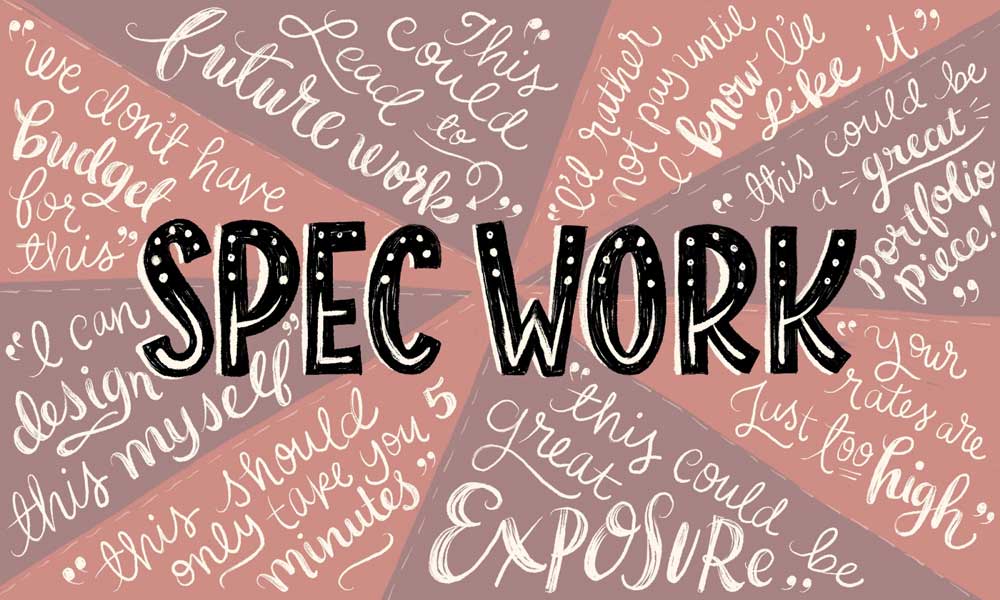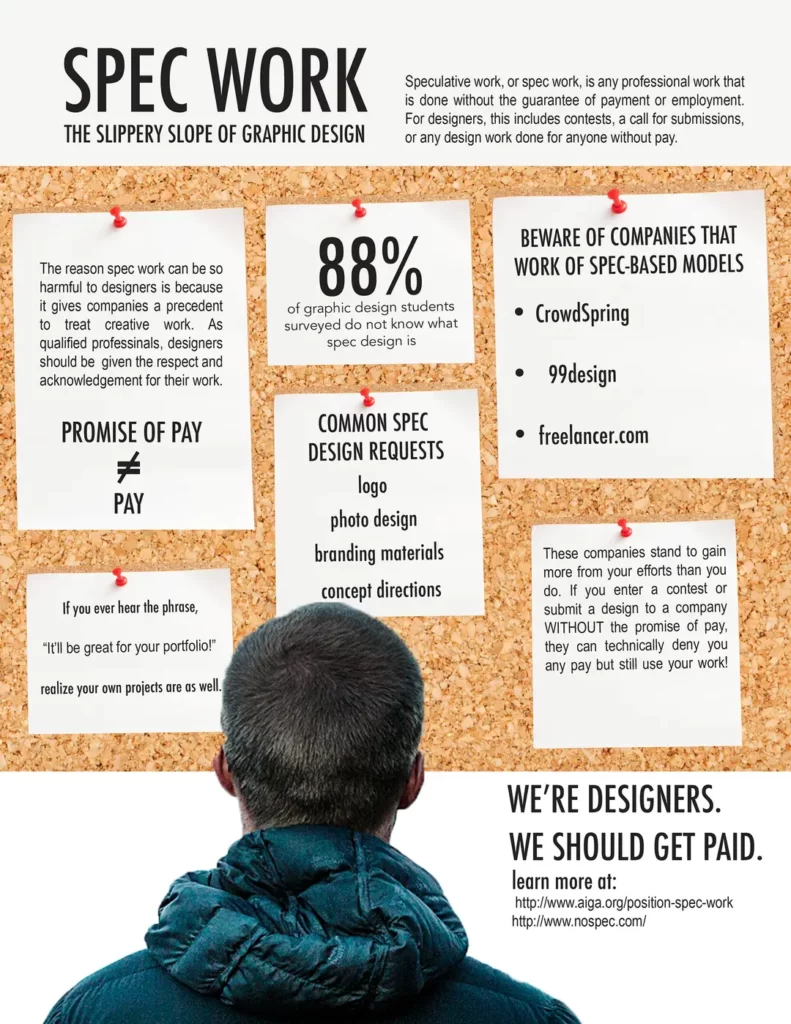Say No to Spec Work! The Dark Side of Design
Are you a designer who's tired of working for peanuts? You may be a freelancer looking to gain experience and build your portfolio. Whatever your situation, you may have considered trying your hand at spec work.
Spec work, for those who aren't in the know, is when a designer creates a mock-up or sample of a design project for a potential client without any guarantee of payment.
Sure, you might come across suggestions to enter competitions or volunteer designs for businesses online. But be warned – websites like 99designs and Crowdspring hold deadline-centric and demanding competitions. These contests require designers to create various interpretations of a client's demand in a short amount of time. It's like trying to make the perfect Instagram caption in 5 seconds flat.
And even if you do deliver your best work on time, there's no guarantee you'll get paid. Clients can refuse to pay or demand a refund if your work fails to meet their ever-changing standards.
So, what's a designer to do? First off, say no to the work. You are worth more than that. Instead, focus on building a solid portfolio and networking with potential clients. And if you do decide to enter a competition, read the fine print carefully and ensure you're not being taken advantage of.
Remember, you're not just a designer – you're an artist. Your creativity and expertise should be valued and respected. Don't let anyone tell you otherwise.
Table of Contents
What is Spec Work exactly?

Spec work – it's like the blind leading the blind. Clients want to see a sample or finished design before they're willing to part with their hard-earned cash. But how can a designer create a masterpiece without knowing what the client wants?
And now, it has become an online competition where designers must convey their ideas according to a client's specifications and demands.
Then, the client picks whichever idea they like best and pays for it – leaving the rest of the designers to watch in despair as their work and effort go down the drain.
And let's remember the horror stories of clients rejecting the work and refusing to pay because it doesn't meet their ever-changing standards. It's like trying to please a toddler with food – no matter what you do, they'll never be satisfied.
It might seem tempting for freelancers and beginners, but the cons far outweigh the pros for clients and designers. Many beginners are unaware of the damage done to their craft and dignity in the process.
But it's not just the designers who suffer. Clients are also affected by it. They're missing out on the opportunity to build a relationship with a designer who truly understands their brand and vision.
What Are The Pros And Cons For The Client?

It might be controversial and unethical, but there are some underlying benefits for clients. And by benefits, we mean the designer's bereavement. So, what exactly are the pros for clients in this approach?
- First and foremost, it's affordable. Let's face it – who doesn't love a good bargain? Companies with a significant online presence always look for cheap solutions. But with spec work, clients can get many designs for a fraction of the cost.
- And regarding designs, clients can get hundreds of options while only paying for one. It's like going to an all-you-can-eat buffet and only paying for one plate – a dream come true for penny-pinchers. Improper companies and brands look for solutions that provide more for less, which fits the bill perfectly.
- But let's not forget the most crucial benefit of spec work – the ability to crush a designer's hopes and dreams. Who needs empathy and compassion when you can get a cheap design? It's like playing a game of Jenga and enjoying watching the tower crumble – pure satisfaction.
In all seriousness, while there might be some benefits for clients in spec work, it's important to remember that it's not worth the damage it can do to the industry and the professionals working in it. So, let's end this cycle of exploitation and focus on building respectful and beneficial relationships between clients and designers.
Spec work might be cheap but comes at a cost – not just to the designer. As a client, there are some cons you should consider before jumping on the bandwagon.
- First and foremost, there's the risk of plagiarism. With these competitions happening all the time online, unoriginal ideas are encouraged, and plagiarism becomes a real possibility. And let's be honest – nobody wants to be known as the company that stole someone else's design.
- Another significant con of spec work is the mediocre quality and limited revision. Sure, you might get a design for a fraction of the cost, but what's the point if it's not up to par? And with limited revisions, you're stuck with a subpar design, unable to make any significant changes to improve it. And in a constantly evolving marketplace, that's a considerable disadvantage.
- And let's remember the designer's mental and emotional state. While watching a designer's hopes and dreams crumble might be funny, it's important to remember that these are real people with real feelings. It can be demotivating and discouraging, leading to burnout and an overall decrease in the quality of work.
So, before you decide to go for the cheap option, consider the potential risks and downsides. Remember, you get what you pay for – and with spec work, that might not be much.
What Are The Pros And Cons For Designers?

One of the most common arguments that pro-spec designers present is that it helps new designers gain valuable experience.
Let's be honest: most seasoned designers don't see any pros to spec work. But for those in favour of it, there are a few arguments they like to make.
- First, they'll tell you about the comprehensive outreach and the possibility of surpassing the contest with your skills. With so many designers competing, standing out can be challenging – but if you manage to do so, it could lead to some exciting opportunities.
- Another pro of spec work is the variety of work to choose and deliver, which can give new designers valuable experience. Plus, if you're a startup looking to create a portfolio, it can be a helpful way to build your portfolio quickly.
- And finally, projects can open doors to meeting peers in the industry. You never know whom you might encounter during a competition, and networking can be crucial to any successful career.
Of course, these arguments are highly subjective, and the pros and cons of spec work are hotly debated in the industry.
It can be a double-edged sword, especially for designers trying to make a name for themselves. While it may seem like an excellent way to gain experience and exposure, the cons of spec work far outweigh the pros.
- Many talented designers undervalue their craft and expertise by participating in unpaid work. The time and effort spent creating designs that may not even be compensated for can be demoralising and degrading. It also sets a precedent for the industry that clients can obtain design work without fair compensation.
- Furthermore, designers are not guaranteed to be compensated for their efforts. It's common for clients to refuse payment or demand a refund if the work does not meet their expectations. This leaves the designer with wasted time and resources and no legal protection for their work.
- On the other hand, winning a spec work competition does not necessarily guarantee that the designer's work will be used or compensated fairly in the future. There is no guarantee that a client will continue to work with a designer or provide ongoing projects.
- Lastly, spec work competitions are often judged solely on personal preference rather than professional standards. Winning designs may not be the best in quality, professionalism, or creativity. It's like playing a game of chance, which may only sometimes work out in the designer's favour.
Overall, it is a risky game, and designers should avoid it whenever possible. The best way to gain experience and exposure in the design industry is through networking, building a solid portfolio, and working with reputable clients who value their craft. As they say, “you get what you pay for,” and this is no exception.
How Spec Work Desecrates the Art of Design

The American Institute of Graphic Arts takes a strong stance against spec work and its impact on the quality and professionalism of design. According to AIGA, it encourages compromising quality, which can harm a client's expectations. Moreover, they consider it to violate a long-standing ethical standard in the communication design profession worldwide. They also warn against any practices related to spec work, especially the requisition of artwork without a promise of the payment beforehand.
AIGA emphasises that clients and companies asking for speculative work may not realise the ethical implications of their actions. Unsurprisingly, beginners in the design field may find it tempting, only to be disappointed when clients reject their hard work.
It should be distinct from crowdsourcing, even though many websites and clients claim to be crowdsourcing firms.
Crowdsourcing allows designers to contribute their skills and ideas to a project without any risk of being unpaid. However, spec workforces designers to compete for a single prize, which may need to be more worth the effort and time spent.
While it may seem like a quick and easy solution for clients, it has profound ethical implications and consequences for designers. As the AIGA emphasises, you should never compromise the value and integrity of the design.
Difference between Spec Work and Crowdsourcing
The two sides of the design industry coin, and boy, are they different.
Spec work is like that friend who always asks for favours but never returns them. You know, the one who texts you at 3 am asking for a ride to the airport but conveniently forgets to mention the gas money. Yeah, that's spec work.
On the other hand, crowdsourcing is like that buddy who always brings good vibes and chips to the party. They want your opinion, your input, and your creativity. They're the Robin to your Batman, the milk to your cereal, the yin to your yang. You get the idea.
Crowdsourcing involves asking for feedback, ideas, and contributions from a group. It's a collaborative effort that benefits both parties.
Spec work, on the other hand, is a one-sided affair. It's like going on a first date and the other person expecting you to foot the bill, and then maybe, they'll consider going on a second date. Not cool, right?
It is the bane of every designer's existence in the design world. It's like having a boss who asks you to work overtime for free. No, thank you. And it's not just about the lack of compensation. It's also about more respect for the designer's time, effort, and creativity.
How Is Spec Work Unethical?

The lack of compensation for the effort and time put into spec work is not only discouraging, but it's also unethical. It's like going to a restaurant, ordering your favourite dish, and refusing to pay because it didn't meet your expectations.
Moreover, spec work promotes false advertisements and competitions that exploit designers' talents. It's like a talent show where the judges have no credibility, and the contestants are just there for the exposure.
In the end, designers end up losing their time, effort, and ownership of their work. Spec work undermines the art form of design and demeans the efforts of designers. It's like asking a magician to perform their best trick and not paying them because you already know how it's done.
So let's stop treating designers like a deck of cards to be shuffled through until we find the right one. Let's value their time, effort, and creativity and pay them what they're worth.
Why You Should Not Promote It
Spec work is a breeding ground for unethical practices in the design industry. It can lead to many problems, from plagiarism to unoriginal ideas. Creating a logo is a challenging task. It requires extensive research, planning, and creativity. Unfortunately, spec work can push logo designers to cut corners and resort to plagiarism to win competitions or get their work selected.
The problem with spec work is that it incentivises designers to prioritise winning over creating original, high-quality work. Instead of brainstorming and creating unique ideas, they may copy ideas from other designs and artists. This undermines the design industry's creativity and integrity and hinders young designers' growth and development.
Moreover, spec work promotes clichéd and unoriginal ideas, harming the client. A logo or design that is not original may fail to connect with the intended audience, resulting in poor brand recognition and sales. It is also worth noting that it does not guarantee or promise future work or payments, so designers can waste their time and effort without compensation.
To sum up, promoting or facilitating spec work can lead to numerous unethical practices that harm the design industry and hurt clients and designers. Promoting fair and ethical practices that value creativity, originality, and hard work is vital.
Conclusion
It's not always a bad idea to work for free…seriously! Especially if it's for a good cause. Don't believe me? Let me explain.
If you're a newbie in the design world and itching to build up your portfolio and gain some experience, there are other ways to do it besides selling your soul to corporate overlords. Consider working with a local non-profit organisation or an NGO (a non-governmental organisation for non-acronym aficionados). Not only will you be able to sharpen your design skills, but you'll also be doing something good for the world. Win-win, baby!
You know, that practice where clients want to see many design options before deciding to pay you? Yeah, that one. It's a total compromise. The clients sacrifice quality for quantity and variety, while the designers get taken advantage of. It's not a good look.
Industry pros and organisations (like AIGA) have spoken out against spec work. And for a good reason! It doesn't just diminish the value of the design industry, but it also undermines the skills and capabilities of designers themselves. So, let's all agree to ditch the spec work and start valuing the hard work of our fellow creatives. Sound good?
